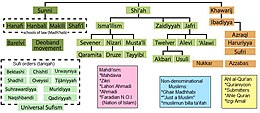|
Salihiyya
 Salihiyya (Somali: Saalixiya; Urwayniya, Arabic: الصالحية) is a Tariqa (order) of Sufi Islam prevalent in Somalia and the adjacent Somali region of Ethiopia. It was founded in the Sudan by Sayyid Muhammad Salih (1854-1919). The order is characterized by fundementalism. HistoryThe order ultimately traces its origins back to the Sufi scholar of Moroccan origin Ahmad ibn Idris al-Fasi (1760-1837). His followers and students spread al-Fasi's teachings across the globe. His nephew, Sayyid Muhammad Salih, was one of them; he spread the Idrisiyya to the Sudan and Somalia, establishing his own eponymous path, the Salihiyya.[1] A former slave, Muhammad Gulid (d. 1918), was instrumental in popularizing the Salihiyya in the Jowhar region of Somalia, while Isma'il ibn Ishaq al-Urwayni spread it in the Middle Juba region. [2] The Salihiyya path which rejects seeking intercession from Saints in one's invocation of God, which it labels as Shirk[3] and is staunchly opposed to the Qadiriyya order (which is the largest and longest-established in Somalia), taking issue with the Qadiri doctrine of Tawassul (intercession), while the Qadiriyya upheld the traditional Sufi belief in the power of intercession held by Saints.[3] The Salihiyya was also militantly anti-colonial.[4] Mohammed Abdullah Hassan, a Salihiyya shaykh and poet, spread the Salihiyya (particularly in Ogaden) and led an armed anticolonial resistance movement in the Horn of Africa under the auspices of the order.[5] See alsoBibliography
References
|
